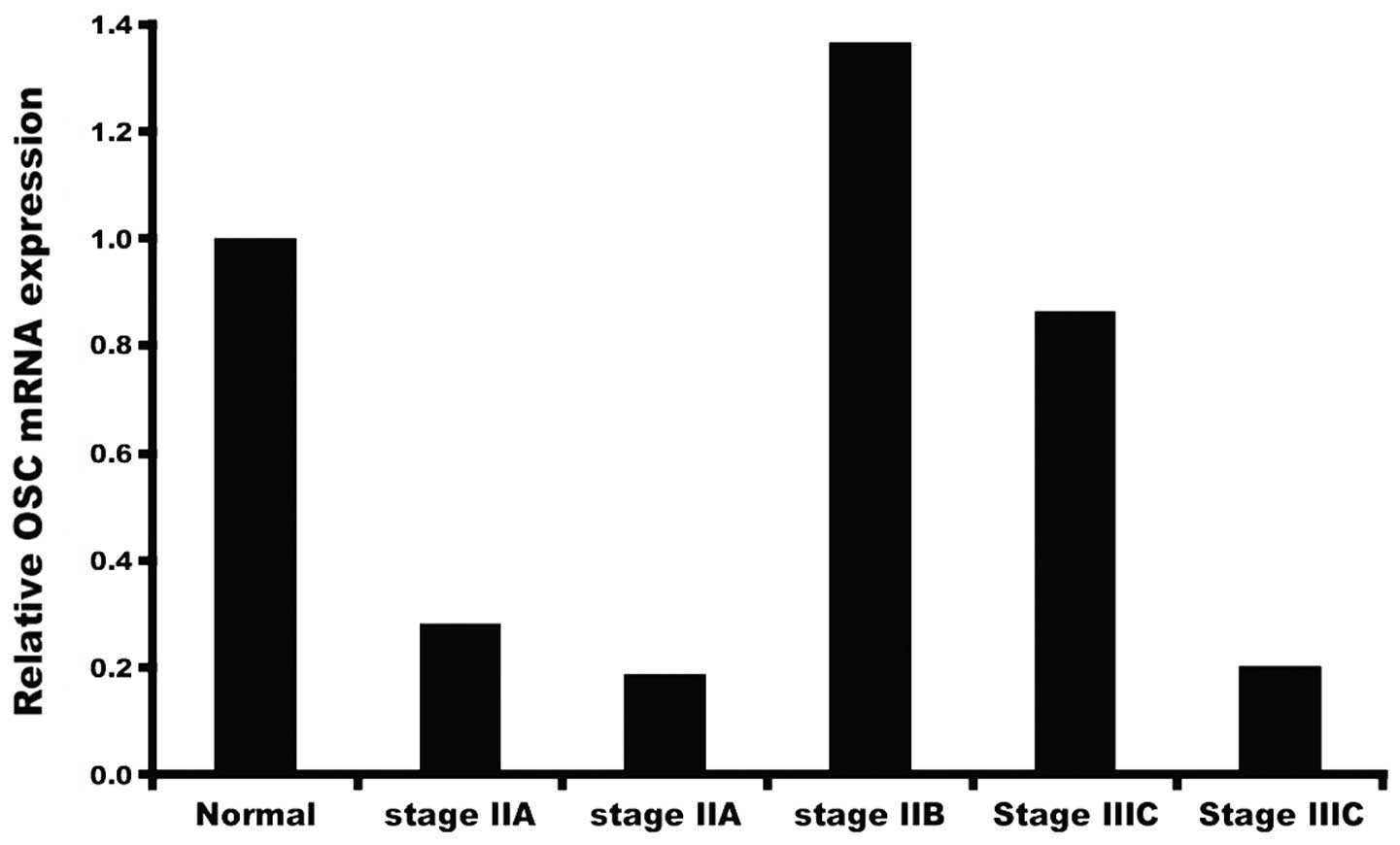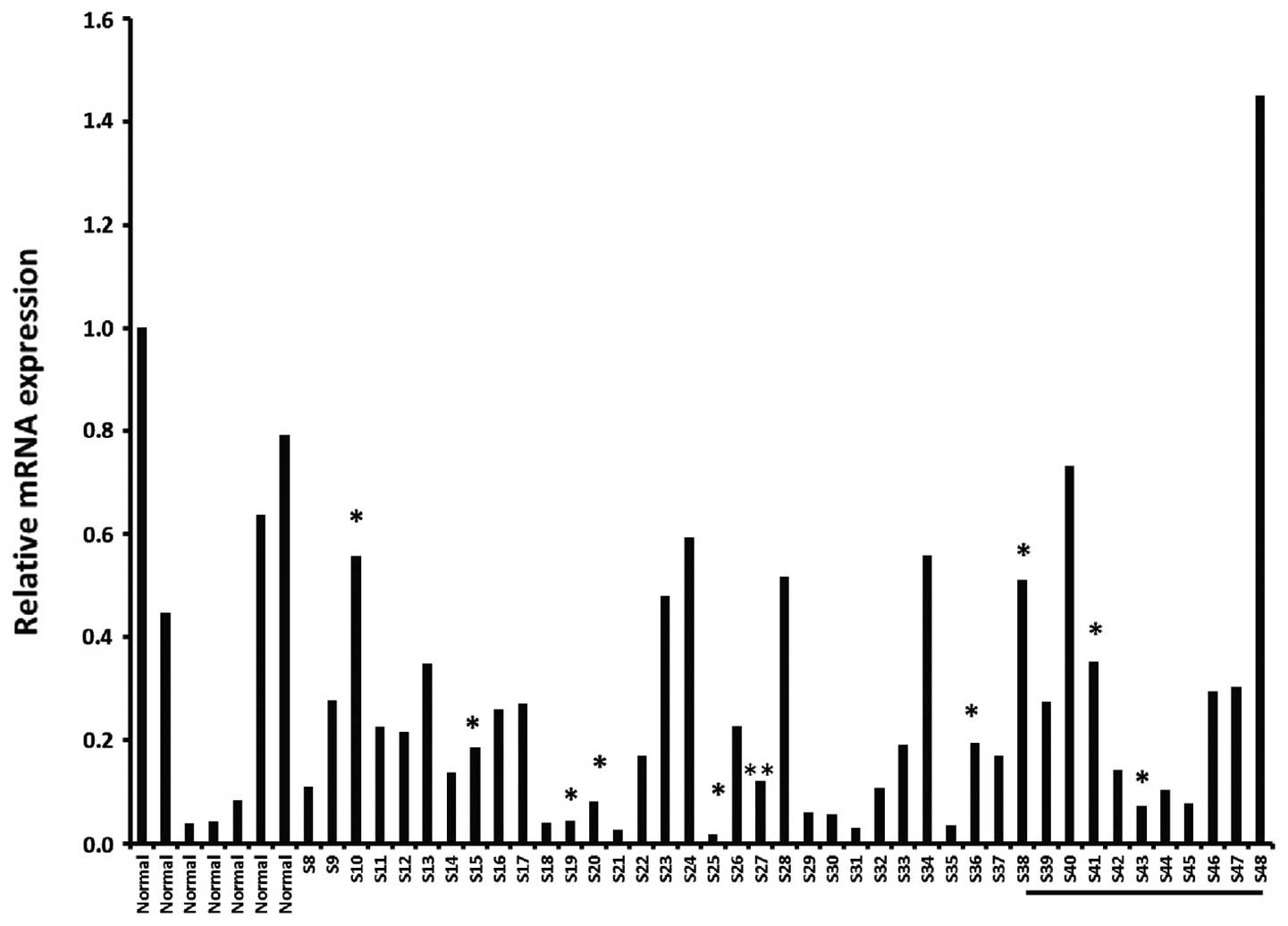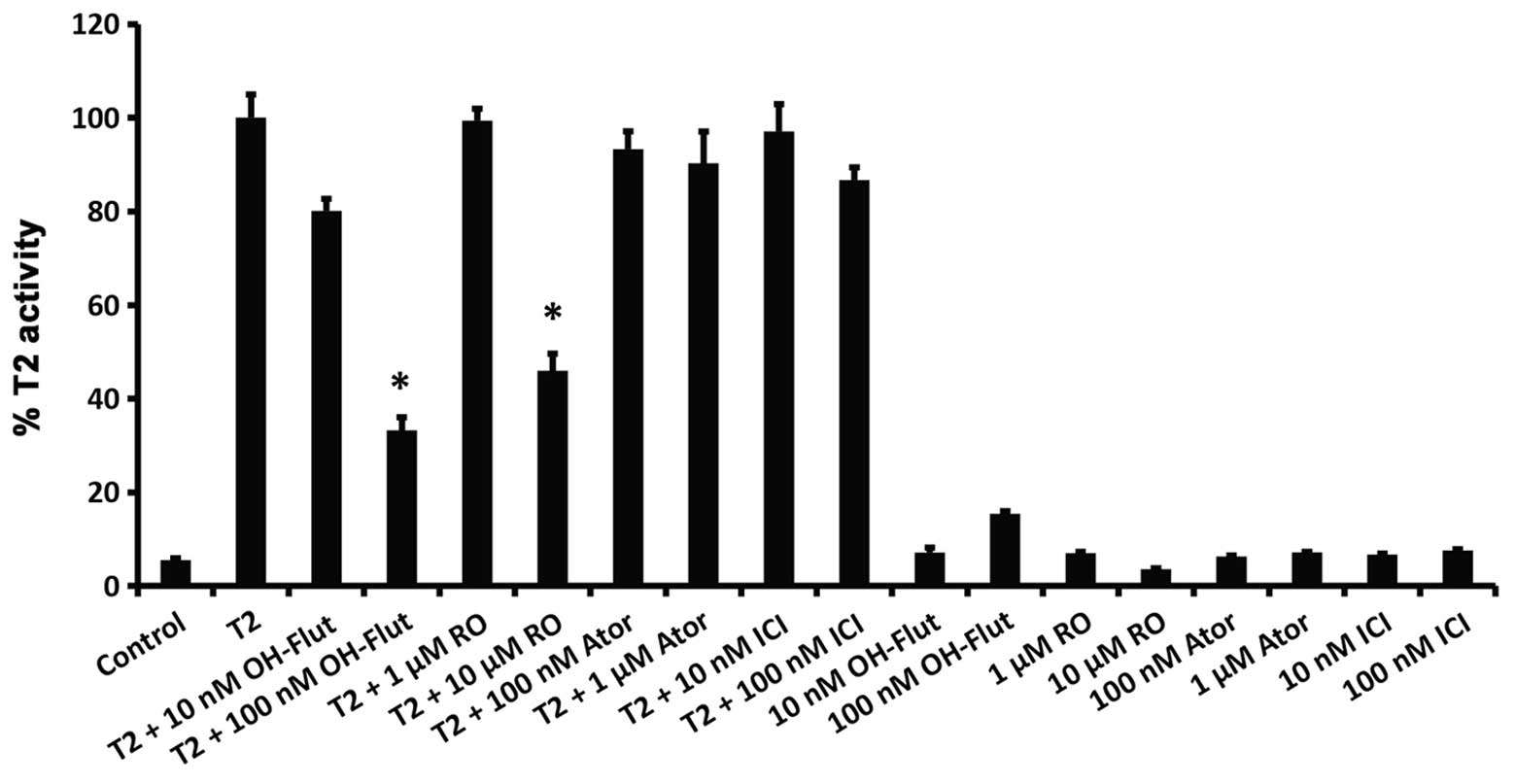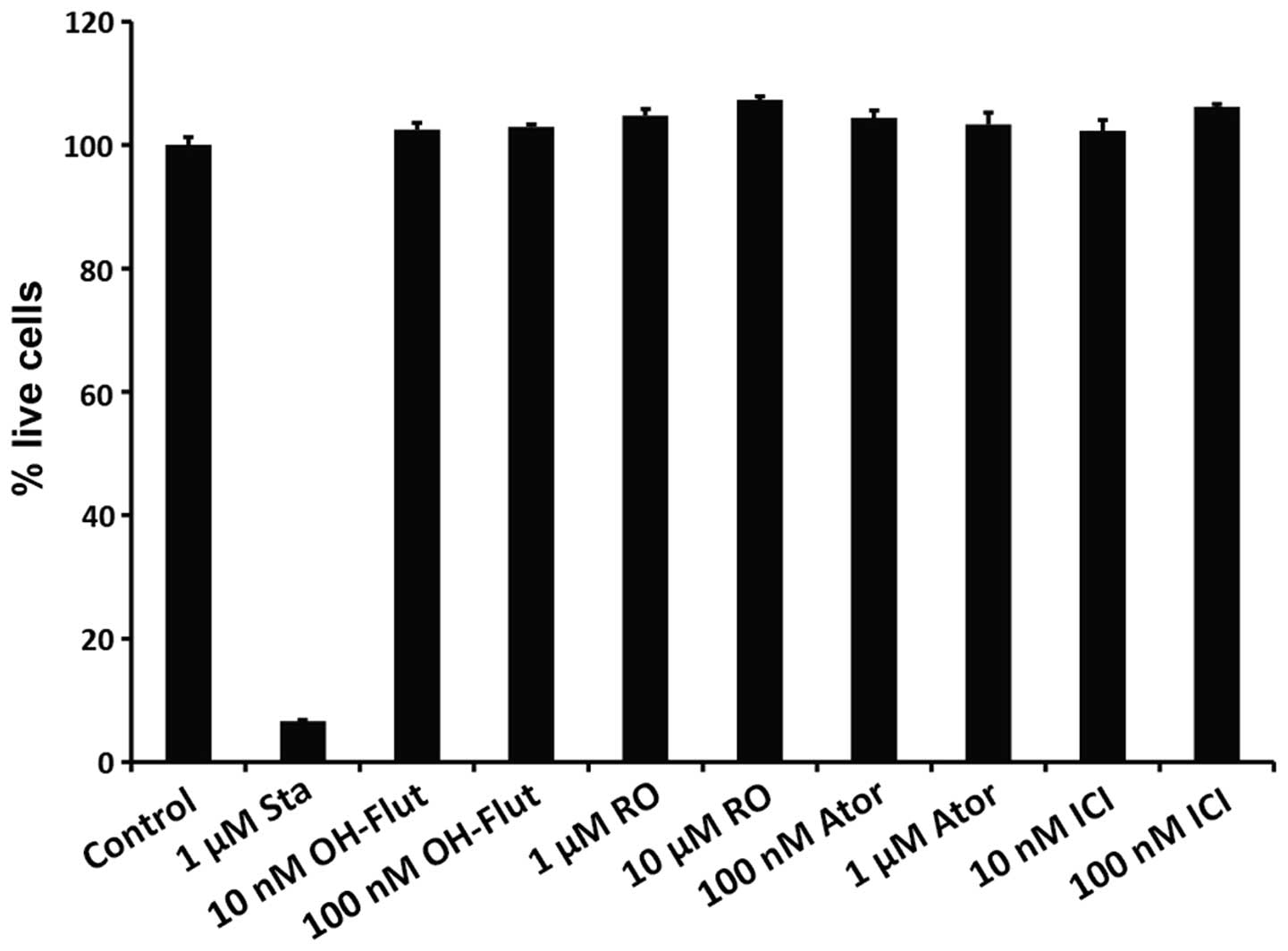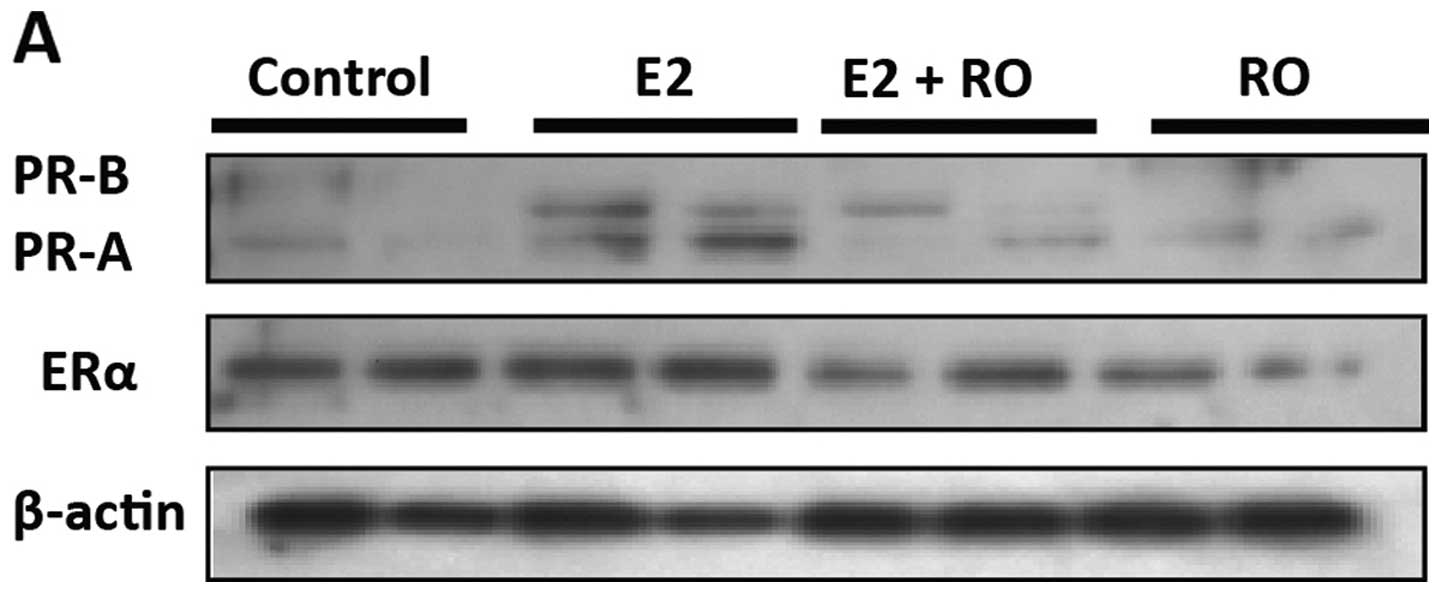Cholesterol synthesis inhibitor RO 48-8071 suppresses transcriptional activity of human estrogen and androgen receptor
- Authors:
- Published online on: July 15, 2014 https://doi.org/10.3892/or.2014.3332
- Pages: 1727-1733
Abstract
Introduction
It is becoming increasingly apparent that cholesterol and its metabolites contribute to the development of breast cancer (1–3). Various mechanisms by which cholesterol promotes the growth of breast tumors have been identified; cholesterol is also the precursor of steroid hormones such as estrogen and testosterone, both of which have well-recognized tumor promoting effects (4). The cholesterol metabolite 27-hydroxycholesterol has been shown to exert selective estrogen receptor modulation (SERM) effects (5,6) and also to promote the growth of estrogen receptor (ER)-positive breast tumors (3). Current evidence, therefore, suggests that by disrupting cholesterol biosynthesis, we may inhibit cell cycle progression and induce cell death (7). Most previous studies have targeted HMG-CoA reductase, a rate limiting enzyme in the cholesterol biosynthetic pathway. However, using in silico analysis, we recently found that oxidosqualene cyclase (OSC), which is downstream of HMG-CoA reductase and is a critical enzyme that catalyzes the cyclization of 2,3-oxidosqualene to lanosterol, may also be a potential target by which to control the proliferation of ER+ve tumors (8). On the basis of these initial findings, and after examining the effects of different OSC inhibitors on human breast cancer cells, we selected RO 48-8071 (RO) as a prototype inhibitor. Our decision to use RO was also based on the aforementioned study where we showed that the compound is a suitable candidate for suppressing human breast cancer cells in vitro (8).
Since there are differences in intra-tumor estrogen levels between ER+ve and triple negative breast cancer tissue (9), we hypothesized that the levels of enzymes involved in the cholesterol biosynthetic pathway may be altered in breast cancer cells. This could include differential expression or activity of OSC. Taking this into consideration, we measured levels of OSC in a panel of human breast cancers and normal tissues and found no significant difference in levels of OSC mRNA between steroid responsive and hormone-independent tumors. Furthermore, OSC expression in tumor tissue was not significantly different than in normal mammary tissue, suggesting that RO must suppress breast cancer cell growth via alternative, off-target effects. In this respect, we discovered that RO suppresses the transcriptional activity of ERα and to some extent that of ERβ, under conditions that preserve cell viability. Moreover, RO also suppresses androgen receptor (AR) transcriptional activity, another major determinant of breast cancer progression (10). Using western blot analysis, we verified that RO suppresses levels of progesterone receptor (PR), the expression of which is directly controlled by ERα in human breast cancer cells (11). This confirms that the ERα-mediated signal transduction pathway is inhibited when cells are exposed to RO.
Materials and methods
RO 48-8071 was purchased from Sigma, dissolved in DMSO and stored in aliquots at −20°C prior to use.
Human tissue qPCR
qPCR-ready TissueScan™ cDNA Array (OriGene starter kit, cat. no. TSRT101) was initially used to determine the expression of OSC in human breast cancer tissues following guidelines recommended by the manufacturer. Human breast cancer tissue array (cat. no. BCRT101) was then used to measure OSC expression in tissues that either expressed ER, PR and HER2 (hormone-dependent) or tissues lacking these receptors (triple negative) at different stages of development (stage I–III). Human OSC (Hs00158906_ml LSS) TaqMan Fam probes were obtained from Applied Biosystems and normalized with human GAPDH (Hs03929097_g1 FG). Relative gene expression was determined using the following formula: Fold-change in gene expression, 2-ΔΔCt = 2 - {ΔCt (cancer tissue samples) - ΔCt (normal tissue)}, where ΔCt = Ct (OSC) - Ct (GAPDH), where Ct represents threshold cycle number.
Luciferase activity
Receptor assay systems were obtained from Indigo Biosciences (State College, PA, USA) and luciferase activity was determined following the manufacturer’s recommended protocol. The assays comprised non-human mammalian cells engineered to express human ERα, ERβ, androgen receptor (AR) protein and luciferase reporter gene functionally linked to the corresponding nuclear receptor-responsive promoter. We initially used Indigo Biosciences Receptor Assay (cat. no. IB00421-48P) to determine the effects of RO on estradiol-induced ERα and ERβ activity. ICI 182,780 was used as a reference antagonist to 17β-estradiol. Since our initial results showed more pronounced effects of RO on ERα activity compared with ERβ, we focused on ERα-promoter linked activity using Indigo Biosciences Receptor Assay (cat. no. IB00401). We also determined the effects of a commonly used cholesterol inhibitor, atorvastatin (Ator) on ERα promoter-linked activity. Since there is increasing evidence to support the role of AR in the development of breast cancer (10), we conducted studies to assess the effects of RO on AR-dependent luciferase activity. A human AR reporter assay system (cat. no. IB03001; Indigo Biosciences) was used with 6α-F1 testosterone as the reference agonist for AR. For all reporter studies, we sequentially used fluorescence-based LCM assays (cat. no. LCM-01; Indigo Biosciences), following the manufacturer’s guidelines, to determine the relative number of live cells at the assay endpoint. All luciferase assays were read with GloMax®-Multi+ Microplate Multimode Reader system (Promega).
Western blotting
BT-474 breast cancer cells were grown in a humidified atmosphere of 5% CO2 at 37°C in 100-mm cell culture plates using phenol red-free Dulbecco’s modified Eagle’s medium (DMEM/F12) supplemented with 10% fetal bovine serum. When cells reached 50–60% confluence, they were washed with PBS and switched into DMEM/F12 supplemented with 5% dextran-coated charcoal (DCC) for 24 h. Cells were then washed, transferred into fresh DMEM/F12 and treated with E2 (10 nM) in the absence and presence of RO (5 μM) or with RO alone. Cells were treated with RO for 3 h prior to treatment with E2 for 16 h, after which cells were harvested. Nuclear protein was extracted following the manufacturer’s guidelines (cat. no. 40010; Active Motif, USA). Protein aliquots (20 μg) were separated by SDS-PAGE, transferred to polyvinylidene difluoride membrane and blotted with the following human specific antibodies: ERα (SC-8005, 1:200 dilution), ERβ (SC-8974, 1:200 dilution), PR (SC-810, 1:200 dilution) (all from Santa Cruz Biotechnology), β-actin (Sigma-Aldrich, St. Louis, MO, USA). Protein bands were detected and quantified by blotting with anti-mouse secondary antibody (SC-2005, 1:10,000 dilution), or anti-rabbit secondary antibody (SC-2004, 1:10,000 dilution) (both from Santa Cruz Biotechnology), and a chemiluminescent detection system according to the manufacturer’s instructions (Amersham Pharmacia Biotech).
Real-time PCR
Total RNA was extracted from two distinct breast cancer cell lines, BT-474 and T47D cells, which express both ERα and ERβ. Cultured cells were treated with 20 μM RO for 1, 3, 6 and 24 h, respectively. Control samples were treated with ethanol, the vehicle medium in which RO was dissolved. RNA was extracted using an EZ-Bioresearch RNA Isolation kit (cat. no. R1002-50) according to the manufacturer’s instructions. Two micrograms of RNA were reverse transcribed into cDNA using a high capacity DNA synthesis kit (cat. no. 4368814; Applied Biosystems). cDNA was then amplified using an ABI 7300 Real-Time PCR Instrument (Applied Biosystems), specific TaqMan primers and TaqMan® Universal PCR Master Mix. Human ERα (Hs00174860_m1), ER-β (Hs00230957_m1) and GAPDH (Hs03929097_g1 FG) TaqMan Fam probes were used (Applied Biosystems). Relative gene expression was determined using the following formula: Fold-change in gene expression, 2-ΔΔCt = 2 - {ΔCt (treated samples) - ΔCt (untreated control samples)}, where ΔCt = Ct (ERα or ERβ) - Ct (GAPDH), where Ct represents threshold cycle number. All reactions were carried out in duplicate for at least three independent experiments.
Statistical analysis
Comparisons were made between multiple groups by analysis of variance (ANOVA) with Neuman-Keuls post-hoc testing. Where normality was not achieved, non-parametric ANOVA (Kruskal-Wallis) and post-hoc Dunn’s test was performed. Significance was defined as p<0.05. Unless indicated, values are shown as mean ± SEM.
Results
OSC mRNA expression in human cancer tissues
In order to measure OSC expression we employed ready to use qRT-PCR human tissue cDNA arrays to obtain preliminary data on levels of OSC mRNA in a limited number of tumors collected at various stages of development (Fig. 1). Our initial study showed that varying levels of OSC message are present in samples of tumor obtained at different stages, and that, depending on the sample, mRNA levels may be higher or lower than levels present in normal breast tissue. This prompted us to analyze a larger cohort of samples and to focus on different breast cancer tissues at different stages (stage I–III) available from OriGene as described in Materials and methods. As shown in Fig. 2, there was no consistency in levels of OSC expression, either within tissue from normal breast, or within breast tumor samples collected at various stages, including triple negative cancers.
Effects of RO on ERα, ERβ and AR-promoter linked hormone responsive luciferase activity
In a previous study, it was indicated that RO reduces breast cancer cell viability in a dose-responsive manner (8). However, since we found levels of OSC mRNA in breast tumors to be inconsistent (Figs. 1 and 2), we concluded that it was unlikely that RO exerts its effects on breast cancer cells primarily by targeting OSC. Previously, we showed that pharmacological levels of RO degrade ERα in breast cancer cells (Liang et al unpublished data). In the present study, we examined whether lower levels of the drug also influenced the transcriptional activity of ER, without degrading the receptor. For these studies, we used steroid receptor-driven luciferase reporter assays (Indigo Biosciences) and concentrations of RO that did not affect cell viability, as determined from a previous study (8), or ERα protein levels. We found that treatment with 1 nM 17β-estradiol for 22 h increased luciferase activity in both ERα and ERβ-linked reporter cells (Fig. 3A and B; bars on left). Induction was much stronger with ERα than ERβ, an observation in accordance with a previous study (12). RO caused a decrease in E2-mediated transcriptional response in a manner that was dose-dependent. Both ERα and ERβ luciferase activities were reduced in response to RO (Fig. 3A and B), although RO-mediated transcriptional suppression was much greater with 10 μM RO when ERα activity was assessed (>50%) than when ERβ induced transcription was measured (<50%).
Having examined the effects of RO on transcriptional activity mediated by both ERα and ERβ, we used ICI 182,780, a well-characterized ERα antagonist, to specifically suppress ERα-mediated transcription (Fig. 3C). ICI 182,780 inhibited transcriptional activity considerably more potently than RO (~1,000-fold), although, notably, atorvastatin, another cholesterol biosynthesis inhibitor that acts on HMG-CoA reductase and is commonly used in humans to lower cholesterol levels, inhibited ERα-mediated transcriptional activity at a level comparable to RO (Fig. 3D). Markedly, RO also inhibited a 6α-testosterone-mediated increase in AR transcriptional activity, which was also blocked by the AR antagonist hydroflutamide (OH-flut; Fig. 4). However, in contrast to their suppression of ERα-mediated transcriptional activity (Fig. 3), neither atorvastatin nor ICI 182,780 had any inhibitory effect on AR-mediated transcription (Fig. 4).
In order to ensure that the observed reduction in luciferase reporter activity was not due to induced cell apoptosis, a fluorescence- based LCM assay kit (LCM-01; Indigo Biosciences) was used concurrently to measure the proportion of live cells in wells where luciferase activity was measured. As shown in Fig. 5, while the proportion of live cells was significantly reduced by the apoptosis-inducing compound staurosporine, all the other compounds tested in the present study were non-toxic at the concentrations used.
Effect of RO on estradiol-induced PR expression in BT-474 human breast cancer cells
Confirmation that RO was able to modify the biological activity of ERα was obtained in BT-474 cells in which ERα regulates PR levels by increasing PR gene transcription (11). As shown in Fig. 6A, treatment of BT-474 cells with 10 nM E2 for 16 h resulted in increased levels of both PRA and PRB. E2-mediated increases in PR levels were blocked by RO (5 μM), without any significant loss of ERα. Real-time PCR confirmed that 5 μM RO had no effect on ERα mRNA expression in human BT-474 or T47-D breast cancer cells (Fig. 6B).
Discussion
There is growing evidence to suggest that cholesterol and its metabolites play an important role in the development of breast cancer (1–3). Previous studies showed that inhibition of cholesterol synthesis at different enzymatic steps of the biosynthetic pathway leads to a suppression of cell growth (13,14), although the significance of OSC in tumor progression remains unclear. OSC is a critical enzyme which is involved in the cyclization of 2,3-oxidosqualene to lanosterol and an increase in its intra-tumor expression or activity has the potential to raise the levels of cholesterol metabolites with estrogenic activities. Such an increase could result in subsequent proliferative effects within breast cancer cells. In earlier studies involving in silico analysis, we showed that RO, an inhibitor of cholesterol synthesis that targets OSC, is a potent ligand with chemotherapeutic properties, which reduces breast cancer cell viability (8). This led us to investigate whether RO may have potential as a chemotherapeutic agent against a broader range of breast cancer cells.
Our initial goal in the present study was to determine whether hormone-responsive and hormone-independent tumors express OSC differently. We hypothesized that differences in OSC expression may partially account for both increased cholesterol biosynthesis and higher levels of intracellular estrogen, which could promote tumor growth. After extensive analysis of a variety of tumor tissues collected at different stages of development and from varying types of tumor, we concluded that there were no significant differences in levels of OSC expression between normal, hormone responsive, hormone-independent and triple-negative breast cancers. It remains to be established, however, whether OSC protein levels are different between the various types of tumor. Based on these observations, we concluded that expression of OSC is unlikely to be a prognostic marker for breast cancer.
In our previous study, we showed that RO significantly reduced the viability of ERα-positive breast cancer cells (8, Liang et al submitted). However, since levels of OSC expression did not vary between different tumor types, we concluded that it is unlikely that the ability of RO to disrupt tumor cell proliferation is due entirely to its inhibition of OSC. Since ERα is a major determinant for human breast cancer cell proliferation, we conducted studies to determine whether RO targets ERα, initially using non-human mammalian cells engineered to express human ERα protein, and luciferase reporter gene functionally linked to an ERα-responsive promoter to assess 17β-estradiol induced luciferase activity. Changes in luciferase expression in cells treated with RO and other test compounds provided a sensitive surrogate measure of changes in ERα transcriptional activity without cellular toxicity. As expected, ICI 182,780, a well characterized antagonist which acts partially through downregulation of the receptor (15), blocked the effects of 17β-estradiol on ERα. RO also inhibited 17β-induced ERα-linked luciferase expression in a dose-dependent manner, although higher doses of RO were required to achieve levels of inhibition comparable to ICI 182,780 (Figs. 3 and 4). RO also blocked ERβ activity, although less potently than its inhibition of ERα. Notably, atorvastatin, an alternative inhibitor of cholesterol biosynthesis which inhibits HMG-CoA reductase, also blocked ERα-mediated transcriptional activity. To determine whether RO, atorvastatin and ICI 182,780 exert differential effects on other steroid receptors, we examined their capacity to inhibit transcriptional activity of AR, our rationale being that AR is also involved in breast cancer progression (10). Among the three ligands tested (RO, atorvastatin and ICI 182,780) only RO inhibited AR-mediated transcription, suggesting that the OSC inhibitor possesses even broader effects than we first anticipated. The ability to block both ER and AR effects possibly indicates that, compared with other chemotherapeutic drugs, RO may have additional advantages with respect to its properties as an anti breast cancer agent.
In our studies using Indigo kits to measure transcriptional activity of nuclear receptors, we utilized non-mammalian cells transfected with human receptor. Following these analyses, we confirmed that RO also affects human breast cancer cells by determining its ability to modify the transcriptional activity of ERα in human BT-474 cells. This was achieved by assessing the effects of 17β-estradiol on ERα-mediated induction of PR protein, measuring levels of the latter by western blotting. PR is directly regulated by ERα in BT-474 breast cancer cells in a ligand-dependent manner (11). Using western blot analysis, we found that RO suppressed induction of PR by 17β-estradiol in human BT-474 breast cancer cells (Fig. 6A). Concomitant analysis of ERα mRNA levels showed that under these conditions, RO did not affect expression of ERα. This confirms, in human breast cancer cells, that RO has the ability to suppress the biological functions of ERα without reducing its levels (Fig. 6A and B).
Given that ERα-induced signal transduction controls the growth of the majority of breast cancers (16), the results reported in the present study suggest that RO has the potential to be an effective chemotherapeutic agent against hormone-responsive breast cancer. Based on our observations of its ability to inhibit the biological activities of both ER and AR, further in-depth analysis of the effects of RO on human breast cancer cells is warranted.
Acknowledgements
The present study was supported by a Department of Defense Breast Cancer Program grant no. W81XWH-12-1-0191, and by a Faculty Research Grant from the University of Missouri, Columbia. S.M.H. is the Zalk Missouri Professor of Tumor Angiogenesis. Funds to purchase the nanodrop instrument were provided through the generosity of numerous donors to the Ellis Fischel Cancer Center. The authors thank Mr. Jason Lee for his assistance with the figures.
References
|
Sivente-Poirot S and Poirot M: Cholesterol metabolism and cancer: the good, the bad and the ugly. Curr Opin Pharmacol. 12:673–676. 2012. View Article : Google Scholar : PubMed/NCBI | |
|
Danilo C and Frank PG: Cholesterol and breast cancer development. Curr Opin Pharmacol. 12:677–682. 2012. View Article : Google Scholar : PubMed/NCBI | |
|
Wu Q, Ishikawa T, Sirianni R, Tang H, et al: 27-Hydroxycholesterol promotes cell-autonomous, ER-positive breast cancer. Cell Rep. 5:637–645. 2013. View Article : Google Scholar : PubMed/NCBI | |
|
Campagnoli C, Pasanisi P, Castellano I, Abbà C, Brucato T and Berrino F: Postmenopausal breast cancer, androgens, and aromatase inhibitors. Breast Cancer Res Treat. 139:1–11. 2013. View Article : Google Scholar : PubMed/NCBI | |
|
Umetani M, Domoto H, Gormley AK, Yuhanna IS, et al: 27-Hydroxycholesterol is an endogenous SERM that inhibits the cardiovascular effects of estrogen. Nat Med. 13:1185–1192. 2007. View Article : Google Scholar : PubMed/NCBI | |
|
DuSell CD, Umetani M, Shaul PW, Mangelsdorf DJ and McDonnell DP: 27-Hydroxycholesterol is an endogenous selective estrogen receptor modulator. Mol Endocrinol. 22:65–77. 2008. View Article : Google Scholar : PubMed/NCBI | |
|
Michikawa M and Yanagisawa K: Inhibition of cholesterol production but not of nonsterol isoprenoid products induces neuronal cell death. J Neurochem. 72:2278–2285. 1999. View Article : Google Scholar : PubMed/NCBI | |
|
Grinter SZ, Liang Y, Huang SY, Hyder SM and Zou X: An inverse docking approach for identifying new potential anticancer targets. J Mol Graph Model. 29:795–799. 2011. View Article : Google Scholar : PubMed/NCBI | |
|
Geisler J, Suzuki T, Helle H, Miki Y, et al: Breast cancer aromatase expression evaluated by the novel antibody 677: correlations to intra-tumor estrogen levels and hormone receptor status. J Steroid Biochem Mol Biol. 118:237–241. 2010. View Article : Google Scholar | |
|
Shah PD, Gucalp A and Traina TA: The role of the androgen receptor in triple-negative breast cancer. Womens Health. 9:351–360. 2013.PubMed/NCBI | |
|
Saceda M, Grunt TW, Colomer R, Lippman ME, Lupu R and Martin MB: Regulation of estrogen receptor concentration and activity by an erbB/HER ligand in breast carcinoma cell lines. Endocrinology. 137:4322–4330. 1996.PubMed/NCBI | |
|
Klinge CM: Estrogen receptor interaction with estrogen response elements. Nucleic Acids Res. 29:2905–2919. 2001. View Article : Google Scholar : PubMed/NCBI | |
|
Chen L, Monti S, Juszczynski P, Ouyang J, et al: SYK inhibition modulates distinct PI3K/AKT-dependent survival pathways and cholesterol biosynthesis in diffuse large B cell lymphomas. Cancer Cell. 23:826–838. 2013. View Article : Google Scholar : PubMed/NCBI | |
|
Fernández C, Martín M, Gómez-Coronado D and Lasunción MA: Effects of distal cholesterol biosynthesis inhibitors on cell proliferation and cell cycle progression. J Lipid Res. 46:920–929. 2005.PubMed/NCBI | |
|
Bachelot T, McCool R, Duffy S, Glanville J, et al: Comparative efficacy of everolimus plus exemestane versus fulvestrant for hormone-receptor-positive advanced breast cancer following progression/recurrence after endocrine therapy: a network meta-analysis. Breast Cancer Res Treat. 143:125–133. 2014. View Article : Google Scholar | |
|
Jensen EV and Jordan VC: The estrogen receptor: a model for molecular medicine. Clin Cancer Res. 9:1980–1989. 2003. |



